Information
LHCb-PAPER-2020-027
CERN-EP-2020-212
arXiv:2012.02696 [PDF]
(Submitted on 04 Dec 2020)
Eur. Phys. J. C81 (2021) 261
Inspire 1835149
Tools
Abstract
Long-lived particles decaying to $e^\pm \mu^\mp \nu$, with masses between 7 and $50$ GeV/c$^2$ and lifetimes between 2 and $50$ ps, are searched for by looking at displaced vertices containing electrons and muons of opposite charges. The search is performed using $5.4$ fb$^{-1}$ of $pp$ collisions collected with the LHCb detector at a centre-of-mass energy of $\sqrt{s} = 13$ TeV. Three mechanisms of production of long-lived particles are considered: the direct pair production from quark interactions, the pair production from the decay of a Standard-Model-like Higgs boson with a mass of $125$ GeV/c$^2$, and the charged current production from an on-shell $W$ boson with an additional lepton. No evidence of these long-lived states is obtained and upper limits on the production cross-section times branching fraction are set on the different production modes.
Figures and captions
|
Production modes of the LLP considered in this search. From left to right: direct pair production (DPP), decay of a SM-like Higgs with a mass of $125 \text{ Ge V /}c^2 $ produced by gluon-gluon fusion (HIG) and production by charged current (CC). |
Fig1.pdf [28 KiB] HiDef png [26 KiB] Thumbnail [14 KiB] *.C file |

|
|
Distributions in data (dashed black histogram) compared to simulated $ b \overline b \rightarrow e ^\pm \mu ^\mp X$ (green filled histogram), showing, (a) $ m_{\text{corr}}$ , (b) the LLP flight distance, (c) the transverse momentum of the muon, (d) the transverse momentum of the electron, (e) the isolation of the muon, and (f) the isolation of the electron. LLP signal distributions are also shown (coloured histograms) for different $ m_{\text{LLP}}$ and $\tau_{\text{LLP}}$ values, where the LLP is produced through the DPP mechanism. The distributions from simulation are normalised to the number of candidates in data. There are no simulated $ b \overline b $ candidates for $ p_{\mathrm{T}} (\mu) < 10 \text{ Ge V /}c^2 $ due to a $ p_{\mathrm{T}}$ requirement at the generation. For the same reason there is a lack of simulated $ b \overline b $ candidates for $ p_{\mathrm{T}} (e) > 15 \text{ Ge V /}c^2 $ as candidates are required to pass the muon or electron trigger. |
Fig2.pdf [158 KiB] Thumbnail [770 KiB] *.C file |
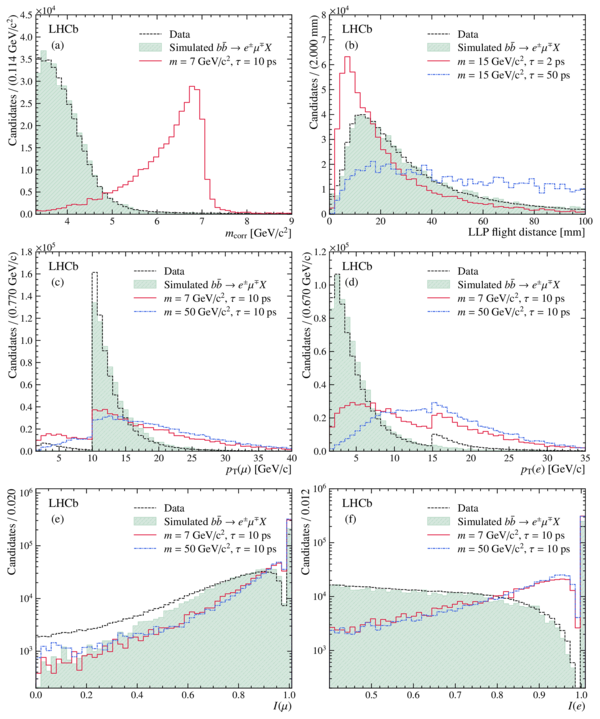
|
|
Distribution of the BDT response in data (dashed black histogram) compared to simulated $ b \overline b \rightarrow e ^\pm \mu ^\mp X$ (green filled histogram) and LLP signal samples (coloured histograms) for different (a) $ m_{\text{LLP}}$ and (b) $\tau_{\text{LLP}}$ values, where the LLP is produced through the DPP mechanism. The distributions from simulation are normalised to the number of candidates in data. |
Fig3.pdf [143 KiB] Thumbnail [363 KiB] *.C file |
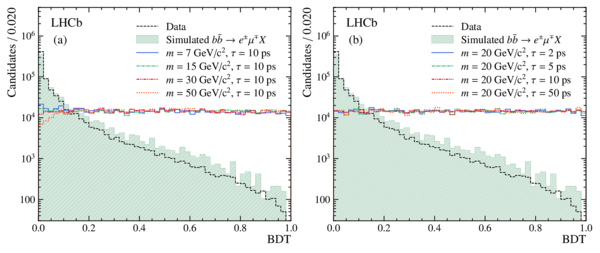
|
|
Distributions of $ m_{\text{corr}}$ (top) and the flight distance (bottom) of two BDT intervals (left and right), where a simultaneous fit result for a LLP signal with $ m_{\text{LLP}} = 47 \text{ Ge V /}c^2 $ and $\tau_{\text{LLP}} = 50 \text{ ps} $ is overlaid; the fitted signal yield in this example is $14 \pm 14$. |
Fig4.pdf [292 KiB] Thumbnail [364 KiB] *.C file |

|
|
Total detection efficiency for LLP produced through the DPP mechanism as a function of $ m_{\text{LLP}}$ (central line) and its uncertainty (coloured band), obtained for different values of $\tau_{\text{LLP}}$ . |
Fig5.pdf [120 KiB] Thumbnail [181 KiB] *.C file |
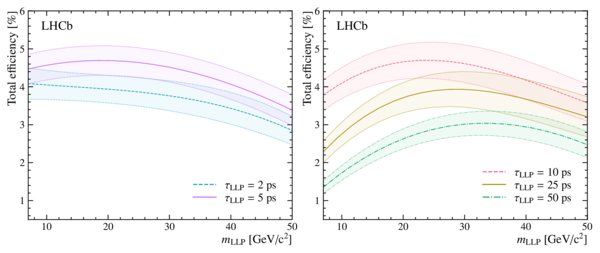
|
|
(a) Expected (open circles and dotted line) and observed (filled circles and solid line) upper limits of the cross-section as a function of $ m_{\text{LLP}}$ for $\tau_{\text{LLP}} = 10 \text{ ps} $, for LLPs produced through the DPP mechanism. The green and yellow bands indicate the quantiles of the expected upper limit corresponding to $\pm1\sigma$ and $\pm2\sigma$ for a Gaussian distribution. (b) Observed limits on the cross-section as a function of $\tau_{\text{LLP}}$ for different $ m_{\text{LLP}}$ values for LLPs produced through the DPP mechanism. |
Fig6.pdf [141 KiB] Thumbnail [173 KiB] *.C file |
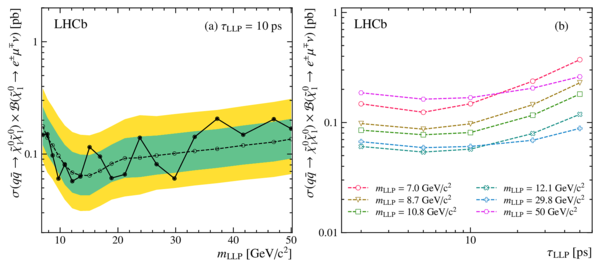
|
|
Observed upper limits on the production cross-sections times branching fraction for (a) $ m_{\text{LLP}} = 7 \text{ Ge V /}c^2 $ and (b) $ m_{\text{LLP}} = 29.8 \text{ Ge V /}c^2 $ as function of $\tau_{\text{LLP}}$ for the DPP, HIG and CC production mechanisms. |
Fig7.pdf [119 KiB] Thumbnail [106 KiB] *.C file |
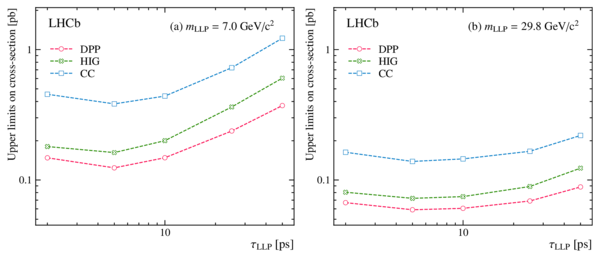
|
|
Observed limits on the $(\sigma / \sigma^{SM}_{gg \rightarrow H}) \times \mathcal{B}( H ^0 \rightarrow \tilde{\chi}^{0}_{1} \tilde{\chi}^{0}_{1})$, assuming $\mathcal{B}(\tilde{\chi}^{0}_{1} \rightarrow e^{\pm}\mu^{\mp}\nu) = 1$ as a function of $\tau_{\text{LLP}}$ for different $ m_{\text{LLP}}$ values. The value of the gluon-gluon fusion production cross-section used is $48.6 \pm 3.5 \text{ pb} $ [47]. |
Fig8.pdf [137 KiB] HiDef png [301 KiB] Thumbnail [186 KiB] *.C file |
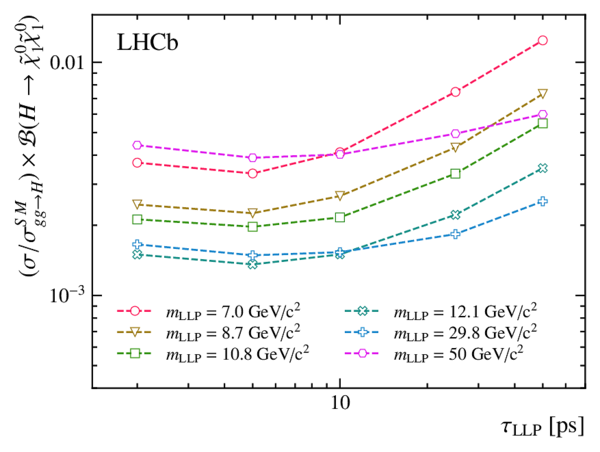
|
|
Animated gif made out of all figures. |
PAPER-2020-027.gif Thumbnail |

|
Tables and captions
|
Contributions to the relative systematic uncertainties in $\%$. The contributions are grouped in three categories, the integrated luminosity, the detection efficiency and the signal yield, separated by horizontal lines. The detection efficiency is affected by the parton luminosity model and depends upon the production process, with a maximum uncertainty of $6.1\%$ for the gluon-gluon fusion process HIG. |
Table_1.pdf [42 KiB] HiDef png [110 KiB] Thumbnail [51 KiB] tex code |

|
Supplementary Material [file]
| Supplementary material full pdf |
supple[..].pdf [76 KiB] |

|
Created on 20 April 2024.
